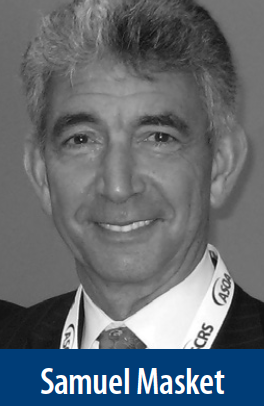
There is an elite assembly of veteran ophthalmic surgeons across the country whose names and faces are synonymous with the strides made in anterior segment surgery during the past quarter of a century. Among them is Samuel Masket, MD, clinical professor of ophthalmology at Jules Stein Eye Institute at UCLA and founding partner of Advanced Vision Care (AVC) in Los Angeles. Dr. Masket recently shared the story of his practice’s evolution, which essentially chronicles the birth and maturation of modern cataract surgery.

CRST: How did AVC originate, and what were your hopes for the practice?
Samuel Masket, MD: I founded AVC in 1977 when I relocated to the West Coast from the metropolitan New York area after 2 years of active duty with the US Navy. I had an academically oriented residency program in New York and was required to spend an additional year performing research. I was excited by both laboratory and clinical research as a resident and published 10 peer-reviewed papers during my training. It was my intention to stay with academia, but an academic opportunity did not present [itself], and I decided to develop an academically oriented clinical practice instead. Nevertheless, I soon obtained a clinical teaching position at UCLA’s Jules Stein Eye Institute [and continue] it to this day as clinical professor.
CRST: What are some of your recollections about the early days of modern cataract surgery?
Dr. Masket: Arriving in Southern California in the 1970s, I witnessed an explosion of technology related to cataract surgery, specifically with regard to IOLs and phacoemulsification. I became enamored with the new science and took an active role in clinical research related to cataract. In the 1980s and 1990s, I published on a variety of related subjects, including posterior iris chafing syndrome and a series of articles regarding the cataract incision and surgically induced astigmatism.
CRST: When did your reputation and AVC’s brand crystalize?
Dr. Masket: Due to the number of publications and presentations to my credit, I was invited to join the editorial board of the Journal of Cataract and Refractive Surgery. For more than 25 years, I have been section editor of its cataract consultation section. As I continued to write and speak on cataract-related matters, I had the opportunity to teach internationally, and the practice developed a reputation for managing difficult cases and complications.
CRST: Can you give us a few examples of how the practice has evolved?
Dr. Masket: The practice grew larger than expected, likely related to published research and referrals for complex case management for things such as post-LASIK cataract and malpositioned IOLs. External marketing did not play a role; rather, the practice’s philosophy, which is consistent with its mission statement, was to place the well-being of the patient as the primary motivator. My mantra has always been, “If it is good for the patient, it is good for the doctor, good for the practice, and good for the industry.” I’ve always practiced with that in mind. As a result, the practice has largely been patient and physician referred.
As the practice developed referral patterns, it became necessary to relocate in 1998 from the San Fernando Valley suburbs to a more central location in Century City near Beverly Hills. Today, we have one location in a medical office building about 1 mile from a shared surgery center. Changes to the physical office have been necessary, and the office has more than doubled in size since 2010.
When the practice was relocated, the intent was to carve out a boutique-style, single-physician practice limited to anterior segment disease, primarily related to cataract. That was the intent, but growth of the practice outpaced my expectations.
CRST: What were some of the challenges AVC faced along the way?
Dr. Masket: Single-physician practices fail with respect to economy of scale. Business potential is lost when the wait time for appointments or surgery is excessive and time is split between the OR and the office-based practice. Additionally, I found that out-of-office professional involvement is a drain on the practice. In particular, I served on the American Academy of Ophthalmology Board of Trustees and the American Society of Cataract & Refractive Surgery’s Executive Committee, [of which I became] president in 2006. The associated time away from the office was quite costly. The obvious answer was to add associate ophthalmologists to the practice. During many years, however, a number of physicians passed through the practice, but none seemed to mesh with the directions, goals, and work ethic of the practice.
CRST: AVC is a group practice, so how did the practice finally find suitable candidates?



Dr. Masket: I so enjoy the serendipity of life. In 2006, a research fellow from Wills Eye Hospital in Philadelphia came to the practice at a request from the hospital’s chief of staff, William Tasman, MD. We all enjoyed her work and suggested that she remain in the practice as an associate, but she had other plans for her life and wanted to return to the East Coast. She suggested that I consider Nicole Fram, MD, who was finishing her year as chief resident at Wills. While interviewing Dr. Fram on a weekend day in my office, a patient presented with an emergency, and I suggested that Dr. Fram evaluate and manage the problem. The manner in which she handled the patient and his condition was exactly as I would have scripted. I knew at that moment that a match had been made.
Dr. Fram went on to complete a corneal fellowship at the University of California, San Francisco Procter Foundation and joined AVC full time in 2008. Her thirst for knowledge and her desire to work hard were evident from day one and continue to the present. She shares the goals of clinical research, presenting at local and national meetings, and publishing the results. Transferring the skills that I developed over the long term to her for dealing with difficult case management was pivotal in branding the practice so more than one surgeon could manage difficult patients and difficult eyes. After a 2-year employment period, she became a partner and has been an equal partner during several years. Transferring responsibility for practice management to her has been pivotal in order to maintain energy, youth, and new vision going forward. As Dr. Fram’s patient volume grew, we decided to further expand our services by adding a glaucoma specialist, Juliet Chung, MD, in 2011 and more recently a well-known corneal surgeon, Neda Shamie, MD, in 2015. A full-time optometrist has also been added to the staff.
CRST: Is there something about AVC that solidifies its reputation as a market leader?
Dr. Masket: From the clinical standpoint, I would say that the quality of our physicians, the quality of care that they provide, and the fact that patients are always put first make the practice excellent. Additionally, maintaining state-of-the-art care and participating in clinical research are a hallmark of the practice. One example of this is the HumanOptics Artificial Iris FDA trial. AVC is one of just 12 sites nationwide approved to participate in the HumanOptics FDA trial. Due to many changes in reimbursement and financing of clinical research, the investigational artificial iris is not covered by health insurance. Nor does the sponsor supply the device that costs $5,000 per unit. Given the expense of the artificial iris, we found it beneficial to develop a nonprofit foundation to raise capital so that patients could participate in the Artificial Iris trial and other clinical research (see Samuel and Barbara Masket Foundation). We are extremely proud of the foundation’s efforts and success at obtaining donations for our needy patients.
CRST: Can you pinpoint a single nonclinical decision that has been crucial to the practice’s success?
Dr. Masket: As the practice evolved from a single physician to a four-physician team, administrative changes also became necessary. Hiring an MBA-candidate chief operating officer has been essential to increasing revenue through more effective and more accurate billing practices.
CRST: What is an example of a worthwhile practice management lesson learned?
Dr. Masket: Like many other practices, [ours has] had to contend with the positive and negative aspects of electronic health records. We stuck with our original system for 5 years and just recently switched over to one from Modernizing Medicine. The prior system proved to be inadequate. Undoubtedly, switching to a new system will present challenges as well, but fortunately, we have an administrative team in place for success. n
Dr. Masket acknowledged no financial interest relevant to the companies or products mentioned herein.
Samuel and Barbara Masket Foundation
A simple observation was behind the establishment of the Samuel and Barbara Masket Foundation: not everyone has the resources to access needed vision care and procedures. The foundation is a 501 C3 nonprofit charitable trust. Its first initiative was donation of the HumanOptics Artificial Iris. The Artificial Iris is currently in FDA clinical trials. Advanced Vision Care is one of 12 sites in the United States approved to implant the device. Atypical of FDAapproved trials, the manufacturer does not supply the device to trial participants, and at a cost of $5,000, the fee is prohibitive as an out-of-pocket expense. Given that the iris device is investigational, health insurance does not cover any of its cost, either. The foundation began fundraising activities in May 2015 and has since donated the cost of the artificial iris for two patients.
The Samuel and Barbara Masket Foundation has a threepronged mission. The first is to provide ongoing ophthalmic research for the benefit of medical professionals and for those in need of better sight. The second is to provide state-of-the-art eye care to patients with inadequate resources. The third is to educate medical professionals and the public about eye diseases and the current research related to those conditions.
Advanced Vision Care’s founding partner Samuel Masket, MD, says, “We at Advanced Vision Care believe that patients have the right to see, that the public has the right to know, and that physicians have the right to learn.”
For more information about the Samuel and Barbara Masket Foundation, the patients who have been helped, and how to make a donation, visit http://www.masketfoundation.org.
WATCH IT NOW
See the artificial iris procedure being performed.





